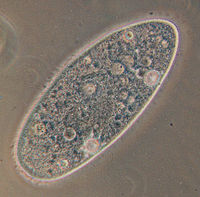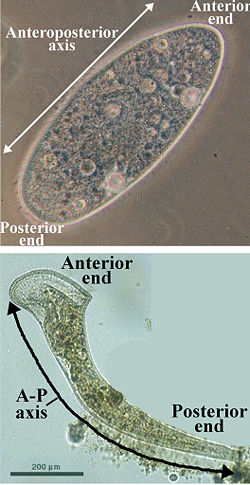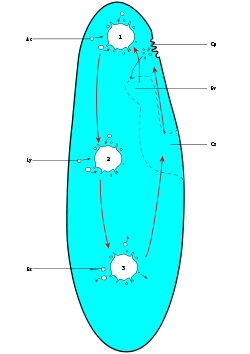Difference between revisions of "Paramecium" - New World Encyclopedia
m (→Nucleus) |
m |
||
| Line 24: | Line 24: | ||
==Nucleus== | ==Nucleus== | ||
[[image:Labelled Ciliates.JPG|thumb|right|250px|Composite image of ciliates, showing anteroposterior axes]] | [[image:Labelled Ciliates.JPG|thumb|right|250px|Composite image of ciliates, showing anteroposterior axes]] | ||
| − | [[image:Paramecium Cyclose.svg|thumb|right|250px|Cyclose of paramecium]] | + | [[image:Paramecium Cyclose.svg|thumb|right|250px|Cyclose of paramecium]]{{Information |
| + | |Description={{en|1=Cyclose of paramecium}} | ||
| + | {{de|1=Cyclose eines Paramecium, Pantoffeltierchen}} | ||
| + | |Source={{own}} | ||
| + | |Author=[[User:RobKohl|RobKohl]] | ||
| + | |Date=2010-02-07 | ||
| + | |Permission= | ||
| + | |other_versions= | ||
| + | }} | ||
| + | |||
| + | [[Category:Ciliophora]] | ||
| + | [[Category:SVG anatomy]] | ||
| + | |||
| + | == {{int:license-header}} == | ||
| + | {{PD-self}} | ||
| + | {{ImageNote|id=1|x=22|y=753|w=112|h=62|dimx=595|dimy=842|style=2}} | ||
| + | caption: | ||
| + | Ac... acidosom | ||
| + | Cp... cytopyge | ||
| + | Cs... cytostom | ||
| + | Ev... entryvacuole | ||
| + | Ex... exocytosevesicle | ||
| + | Ga... gastriole | ||
| + | Ly... lysosom | ||
| + | {{ImageNoteEnd|id=1}} | ||
Paramecia are rare among the [[eukaryotes]] in that they have two different types of nuclei within their [[cell (biology)|cell]]s. ''Micronuclei'' contain normal diploid [[chromosome]]s, divide by [[meiosis]], and undergo [[genetic recombination]]. ''Macronuclei'' are derived from the micronuclei, but contain multiple copies of the genome and the [[DNA]] is divided smaller than individual chromosomes (Raven and Johnson 1996). The macronucleus is responsible for everyday activities including growth and reproduction, and the micronucleus remains dormant until the cell reproduces. | Paramecia are rare among the [[eukaryotes]] in that they have two different types of nuclei within their [[cell (biology)|cell]]s. ''Micronuclei'' contain normal diploid [[chromosome]]s, divide by [[meiosis]], and undergo [[genetic recombination]]. ''Macronuclei'' are derived from the micronuclei, but contain multiple copies of the genome and the [[DNA]] is divided smaller than individual chromosomes (Raven and Johnson 1996). The macronucleus is responsible for everyday activities including growth and reproduction, and the micronucleus remains dormant until the cell reproduces. | ||
Revision as of 18:21, 26 September 2011
| Paramecium | ||||||||||||
|---|---|---|---|---|---|---|---|---|---|---|---|---|
 Paramecium aurelia | ||||||||||||
| Scientific classification | ||||||||||||
|
Paramecium is a well-known genus of ciliate protozoa (single-celled eukaryotes, generally grouped in the kingdom Protista) of the phylum Ciliophora, commonly studied as a representative of that group. Paramecia are unicellular and slipper-shaped organisms found in freshwater environments, ranging from 50 to 300 μm in length, depending on the species. Simple cilia, tiny hairlike filaments, cover the body, and there is a deep oral groove, containing inconspicuous compound oral cilia, as found in other peniculids (order of protozoa). These cilia aid in both movement and in moving food to the oral cavity.
As simple as paramecia are, they nonetheless exhibit a rudimentary sexual reproduction, whereby two paramecium come together, conjugate, and exchange genetic material. Thus, even at this basic level, sexual reproduction is revealed as a nearly ubiquitous characteristic of living organisms. Some species of paramecia also form harmonious, symbiotic relationships with algae, with algae providing the products of photosynthesis to the paramecia, while receiving a habitat in which to flourish.
Movement and feeding
The hair-like cilia that cover the outer body of the paramecium are in constant motion, helping the organism move along at a speed of four times its own length per second. As it moves forward, it rotates on its axis, which aids in pushing food into the gullet. It can move backwards by reversing the motion of the cilia.
Food enters the food vacuoles, which cilia push into the gullet in a process known as phagocytosis, and is digested with the aid of hydorchloric acid and enzymes (Raven and Johnson 1996). When digestion is complete, the remaining food content is emptied into pellicles, known as cytoproct. Osmoregulation is carried out by a pair of contractile vacuoles on either end of the cell, which actively expel water absorbed by osmosis from the surroundings.
Some species of paramecia, such as Paramecium bursaria, form symbiotic relationships with photosynthetic algae. In this case, the paramecium is able to grow certain algae within its own cytoplasm. Living inside of another organism provides a safe habitat for the algae, unless food for the paramecium is scarce, in which case the algae will be consumed for nutrition.
Nucleus
| Description |
(English) This article is based on a translation of the article Cyclose eines Paramecium, Pantoffeltierchen from the German Wikipedia. |
|---|---|
| Source |
Template:Own |
| Date |
2010-02-07 |
| Author |
RobKohl |
| Permission |
see below |

